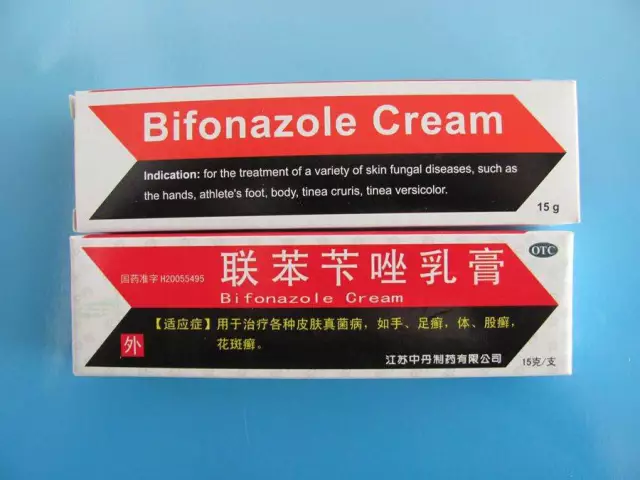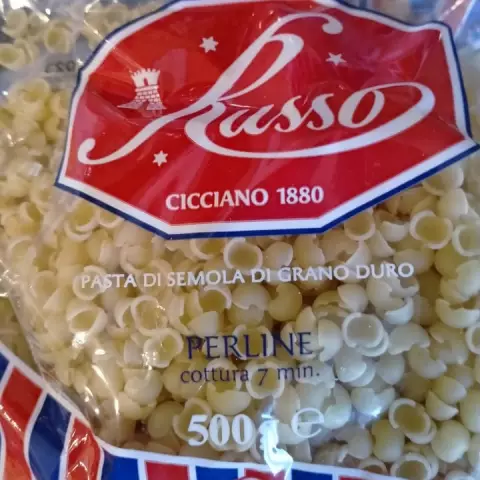- Author Rachel Wainwright [email protected].
- Public 2023-12-15 07:39.
- Last modified 2025-11-02 20:14.
Bifonazole
Instructions for use:
- 1. Pharmacological action
- 2. Release form
- 3. Indications for use
- 4. Instruction
- 5. Side effects
- 6. Contraindications to use

Bifonazole is an antifungal drug.
Pharmacological action of Bifonazole
Bifonazole is a broad-spectrum agent that is active against dermatophytes: epidermophyton, trichophyton, microsporum, yeast-like and mold fungi, pityriasis versicolor, the causative agent of erythrasma.
Release form
Bifonazole cream and ointment, powder and solution are produced.
Indications for use
Bifonazole according to the instructions is prescribed for trichophytosis of the scalp, smooth skin, microsporia, favus, mycosis of the hands, feet, rubrophytia, epidermophytosis, inguinal lichen, erythrasma, candidiasis of the nails and genitals, superficial cutaneous candidiasis, with hyperhidrosis of the feet, onychomycosis.
Good reviews about Bifonazole, used for diaper rash between the fingers.
Bifonazole instruction
For the treatment of fungal infections of large folds, feet, brushes, an ointment, cream or solution is applied once a day before going to bed with a thin layer and rubbed directly into the lesion.
For a lesion the size of a palm, a strip of ointment or cream Bifonazole 0.5 or 1 cm long or three drops of solution is sufficient.
Treatment for mycosis of the interdigital spaces on the feet and skin of the feet lasts 3 weeks, for mycosis of the hands, skin folds and body mycosis - 2-3 weeks; erythrasma, versicolor lichen - 2 weeks; superficial cutaneous candidiasis - 2-4 weeks.

Judging by the reviews about Bifonazole, for the treatment of fungi of the scalp it is better to use a solution that is applied to a previously shaved focus of fungal infection. The treatment lasts a month.
After the manifestations of mycosis disappear, Bifonazole is used for another 10-15 days, using a powder, solution or cream one r / week to prevent relapse.
With onychomycosis, an ointment or cream is most often used to remove the affected nail and destroy the fungus. Bifonazole is applied once a day with a thin layer, after which the nails are covered with a plaster or bandage for a day. After removing the dressing, before replacing it, hands or feet with affected nails should be immersed in warm water for 10 minutes and then removed the infected softened nail. When the fingers are dry, the cream or ointment can be reapplied and bandaged or patch applied. The treatment lasts as long as it takes for the nail bed to become smooth - approximately one to two weeks. Usually, Bifonazole ointment or cream affects only the part of the nail affected by the fungus, but in some cases irritation of the skin around appears: you need to lubricate it with zinc ointment.
Judging by the reviews of Bifonazole, after the main symptoms of the fungus disappear, it is advisable to extend the treatment to 3-4 weeks for the final elimination of the focus of infection.
If treatment with Bifonazole does not bring results, the patient is recommended to be examined additionally: to check the state of the endocrine system, immunity, blood, microcirculation in the area of fungal infection.
Side effects
Bifonazole can cause skin irritation and redness, burning, flaking, maceration, dermatitis.
Contraindications to the use of Bifonazole
Bifonazole according to the instructions is not used in case of hypersensitivity to the active substance of the drug, incl. to lanolin and cetylstearol.
Pregnant women should use the drug with caution. Only under the supervision of the attending physician can Bifonazole be used to treat infants.
Information about the drug is generalized, provided for informational purposes only and does not replace the official instructions. Self-medication is hazardous to health!






